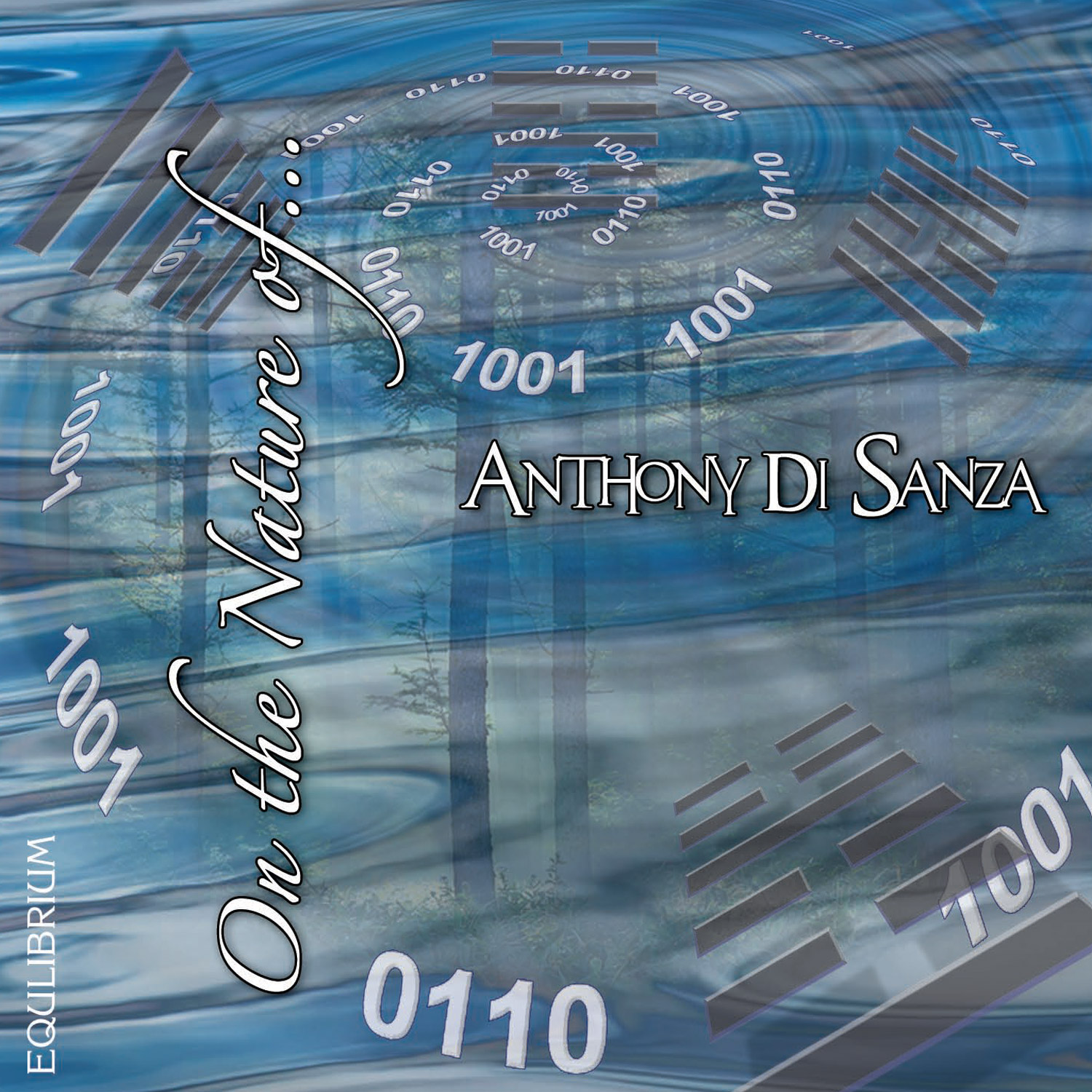 |
|
All Music Guide - June 08, 2011 - by Stephen Eddins
Percussionist Anthony Di Sanza's CD On the Nature of… features three substantial solos works and a concerto. The first three pieces date from the 1980s and are established as classics the modern percussion repertoire. Toshi Ichiyanagi's Portrait of Forest and Jacob Druckman's Reflections on the Nature of Water, both scored for marimba solo, are sophisticated and imaginative evocations of the natural world. Per Norgard's I Ching, in contrast, is scored for what Di Sanza describes as a stage full of percussion instruments drawn from various world cultures. It's a piece that's overwhelming in the impact it makes both in the economy of its gestures and material (movement three, The Gentle, the Penetrating) and in its dazzling timbral richness and variety (movement one, Thunder Repeated: The Image of Shock, which sounds like it would take a stage full of percussionists to create such gigantic torrents of sound). It's a fully satisfying work; the sense of purposefulness and musical integrity that it manages to convey in spite of the enormous range of it stylistic and instrumental diversity is a testimony to Norgard's exceptional gift and skill.
The challenge Di Sanza faced in writing his Concerto for Darabukka and Percussion Quartet was creating a piece in which a non-melodic instrument could hold its own as the featured solo using only rhythm and timbral shading, and he's fully successful in pulling it off. He does expand the variety of timbres by switching between several instruments for the solo part, including West African djembes as well as Near and Middle Eastern darabukkas. It's a wonderfully attractive piece -- colorful, inventive, energetic, and consistently engaging -- that draws on the music of the cultures of its featured solo instruments without sounding derivative. In all of these works Di Sanza dazzles not only in the assurance and polish of his playing but in his tremendous vitality and spontaneity. The sound of the Equilibrium CD is vividly detailed, balanced and entirely clean.
American Record Guide (ARG) - September/October 2011
On the Nature of... is a collection of percussion pieces performed by Anthony Di Sanza and others. The short work by Ichiyanagi is aimless and derivative, but there are two excellent works on the program - the astoundingly difficult (and seminal) I Ching of Norgard, which charted his exploration of the infinity row in a non-pitched context, and the beautiful Reflections on the Nature of Water by Druckman - both performed very well by Di Sanza. The last work on the program is by DiSanza himself, a Concerto for Darabukka and Percussion Quartet. The Darabukka is a middle-eastern goblet-shaped drum. With it (and his quartet) he creates a fascinating work of many facets, influenced by middle-eastern music (of course) and Japanese drumming.
Percussive Notes - Spring 2011
Great compositions gradually reveal themselves to us over long periods of time, both in grand concepts and the most nuanced details, Anthony Di Sanza writes in the liner notes of his new solo percussion recording. It illustrates a decision to record three well- known works from the solo percussion repertoire: Portrait of Forest by Toshi Ichiyangi, I Ching by Per Norgard, and Jacob Druckman’s Reflections on the Nature of Water. In addition to these standards, Di Sanza includes one of his own compositions: Concerto for Darabukka and Percussion Quartet. One objective of the latter work is to celebrate the simplicity of the drum, which he says, continues to inspire musical thoughts and dreams.
Like a well-balanced recital, the programming and pacing provide variety, contrast (emotional and sonic), and stylistic diversity. The recording quality is excellent, especially with the sometimes ethereal sound world of Norgard’s I Ching and creating balance between the subtle darabukka and the powerful/ visceral drumming accompaniment in the concerto. Depth and clarity in Di Sanza’s interpretations are clearly the result of working, performing, and engaging in the creative process with these pieces over many years. While many percussionists work to expand the repertoire for percussion by commissioning new works, it is also wonderful for us to have new recordings of seminal works - those often performed, but perhaps less often recorded. As illustrated by Di Sanza, great performers can produce thought-provoking interpretations and consistently breathe new life into works with each performance, or in this case, recording.
- John Lane
Percussionist Anthony Di Sanza's CD On the Nature of… features three substantial solos works and a concerto. The first three pieces date from the 1980s and are established as classics the modern percussion repertoire. Toshi Ichiyanagi's Portrait of Forest and Jacob Druckman's Reflections on the Nature of Water, both scored for marimba solo, are sophisticated and imaginative evocations of the natural world. Per Norgard's I Ching, in contrast, is scored for what Di Sanza describes as a stage full of percussion instruments drawn from various world cultures. It's a piece that's overwhelming in the impact it makes both in the economy of its gestures and material (movement three, The Gentle, the Penetrating) and in its dazzling timbral richness and variety (movement one, Thunder Repeated: The Image of Shock, which sounds like it would take a stage full of percussionists to create such gigantic torrents of sound). It's a fully satisfying work; the sense of purposefulness and musical integrity that it manages to convey in spite of the enormous range of it stylistic and instrumental diversity is a testimony to Norgard's exceptional gift and skill.
The challenge Di Sanza faced in writing his Concerto for Darabukka and Percussion Quartet was creating a piece in which a non-melodic instrument could hold its own as the featured solo using only rhythm and timbral shading, and he's fully successful in pulling it off. He does expand the variety of timbres by switching between several instruments for the solo part, including West African djembes as well as Near and Middle Eastern darabukkas. It's a wonderfully attractive piece -- colorful, inventive, energetic, and consistently engaging -- that draws on the music of the cultures of its featured solo instruments without sounding derivative. In all of these works Di Sanza dazzles not only in the assurance and polish of his playing but in his tremendous vitality and spontaneity. The sound of the Equilibrium CD is vividly detailed, balanced and entirely clean.
American Record Guide (ARG) - September/October 2011
On the Nature of... is a collection of percussion pieces performed by Anthony Di Sanza and others. The short work by Ichiyanagi is aimless and derivative, but there are two excellent works on the program - the astoundingly difficult (and seminal) I Ching of Norgard, which charted his exploration of the infinity row in a non-pitched context, and the beautiful Reflections on the Nature of Water by Druckman - both performed very well by Di Sanza. The last work on the program is by DiSanza himself, a Concerto for Darabukka and Percussion Quartet. The Darabukka is a middle-eastern goblet-shaped drum. With it (and his quartet) he creates a fascinating work of many facets, influenced by middle-eastern music (of course) and Japanese drumming.
Percussive Notes - Spring 2011
Great compositions gradually reveal themselves to us over long periods of time, both in grand concepts and the most nuanced details, Anthony Di Sanza writes in the liner notes of his new solo percussion recording. It illustrates a decision to record three well- known works from the solo percussion repertoire: Portrait of Forest by Toshi Ichiyangi, I Ching by Per Norgard, and Jacob Druckman’s Reflections on the Nature of Water. In addition to these standards, Di Sanza includes one of his own compositions: Concerto for Darabukka and Percussion Quartet. One objective of the latter work is to celebrate the simplicity of the drum, which he says, continues to inspire musical thoughts and dreams.
Like a well-balanced recital, the programming and pacing provide variety, contrast (emotional and sonic), and stylistic diversity. The recording quality is excellent, especially with the sometimes ethereal sound world of Norgard’s I Ching and creating balance between the subtle darabukka and the powerful/ visceral drumming accompaniment in the concerto. Depth and clarity in Di Sanza’s interpretations are clearly the result of working, performing, and engaging in the creative process with these pieces over many years. While many percussionists work to expand the repertoire for percussion by commissioning new works, it is also wonderful for us to have new recordings of seminal works - those often performed, but perhaps less often recorded. As illustrated by Di Sanza, great performers can produce thought-provoking interpretations and consistently breathe new life into works with each performance, or in this case, recording.
- John Lane



